What does the coming year hold for the housing market? Here’s what experts project for 2022. Mortgage rates are projected to rise and so are home prices. Experts are forecasting buyer demand will remain strong as people try to capitalize on rates and prices before they climb, creating another strong year for home sales. Let’s connect so you can make your best move in the new year.




📞 Call us today!
CA REAL ESTATE GROUP powered by Keller Williams Realty
👩 Christine Almarines @carealestategroup
Realtor DRE # 01412944
714-476-4637 | christine@carealestategroup.com
👩 Michelle Kim @michellejeankim_homes
Realtor DRE # 01885912
714-253-7531 | michelle@carealestategroup.com
For more real estate tips, follow us on FB/IG @carealestategroup
Source: www.mykcm.com/2021/12/17/2022-housing-market-forecast-infographic/
Now that January is just around the corner, we present to you ten resolutions for your home this year, in the perfect spirit of new beginnings. They say home is where your heart is but a lovelier, better organized, and more comfortable place to live will surely work wonders.






CA REAL ESTATE GROUP powered by Keller Williams Realty
 Christine Almarines @carealestategroup
Christine Almarines @carealestategroup
Realtor DRE # 01412944
714-476-4637 | christine@carealestategroup.com
 Michelle Kim @michellejeankim_homes
Michelle Kim @michellejeankim_homes
Realtor DRE # 01885912
714-253-7531 | michelle@carealestategroup.com
For more home maintenance and real estate tips, follow us on FB/IG @carealestategroup
Source: https://www.lifehack.org/354146/10-resolutions-for-your-home-the-new-year

A couple of years ago I went on a search for Basil Hayden’s Bourbon; it had been highly suggested as the bourbon of choice for this amazing stuffing. Sadly I was unsuccessful in my efforts to locate it in Denver and managed to make do with another brand but I will never forget that recommendation from a friend. When I was asked if I would like to recreate the Basil Hayden’s Holiday Spice Cocktail created for the brand by Joaquín Simó who was just named Bartender of the Year at the industry Tales of the Cocktail Convention held each year in New Orleans, how could I say no?
The recipe for this remarkable bourbon dates back to 1796, when Basil Hayden himself was a master distiller. Hayden was born and raised in Maryland, where he learned to make whiskey from rye. When he came to Kentucky, Hayden began making whiskey from a base of corn, but added a higher percentage of rye than other distillers, resulting in a smooth, mild bourbon that was distinctly his own. The abundance of rye gives it a slightly peppery taste and aroma, perfect for sipping on the rocks but also delicious in a well crafted cocktail.

Partnering with Basil Hayden’s, Joaquín has created the quintessential holiday cocktail. The Basil Hayden’s Holiday Spice combines the bourbon’s spicy finish with the winter flavors of maple syrup and cinnamon. Joaquín’s expert mixology skills make the cocktail the perfect addition to any holiday party, or a low-key fireside evening. For Mr. Simó, it’s been an unlikely journey from his native Ecuador to the accolades at the Tales of the Cocktail convention. After finishing his degree in English literature and comparative religion at Boston University he found himself working dive bars and rock ‘n’ roll joints before moving to New York eight years ago where he polished his craft.
Known not just for being a master mixologist, Simo’s engaging manner and eagerness to discuss a wide range of topics with patrons shows a genuine hospitality; combined with his skills with a shaker and jigger make this a most relevant accolade. I was excited about this cocktail for a couple of reasons beyond the bourbon too. The ingredients seemed to sing on paper; how could they not be fabulous mixed together? A great bourbon mixed with lemon juice, maple syrup and cinnamon with just a touch of Amaretto and bitters? I knew I would love it before the first taste and I was right. As much as I do enjoy some specialty cocktails over the holidays; many are sweet concoctions and I was so ready for a big girl drink!
I love that this is a great cocktail for all winter long…maybe someone will gift you a bottle of Basil Hayden’s for the holidays..I sure hope so! CHEERS!
SERVES 2
BASIL HAYDEN’S HOLIDAY SPICE COCKTAIL
10 minPrep Time
10 minTotal Time
- 4 oz Basil Hayden’s Bourbon
- 1 & 1/2 oz Fresh Lemon Juice
- 1 oz Maple Syrup
- 1/2 oz Amaretto
- 6 dashes Angostura bitters
Instructions
- Combine Basil Hayden¹s, lemon juice, maple syrup, Amaretto and bitters in a mixing tin with ice and shake vigorously.
- Strain into a rocks glass over fresh ice.
- Grate a cinnamon stick over the top and add the stick to the cocktail as garnish.
Source: https://creative-culinary.com/basil-haydens-holiday-spice-cocktail-from-joaquin-simo/


Highlights:
🐶 It’s no secret that we love our furry friends – about 70% of U.S. households have pets. What may come as a surprise is how large a role they play in the homebuying process.
🐱 Americans spend $1,163 a year on their pets, and nearly half of pet owners say they would move for better accommodations and amenities for their pets.
🐰 If you’re thinking of adding a furry friend, or if you already have, let’s connect to discuss how you can find a home that meets all your pet’s needs.
📞 Call us today!
Christine Almarines @carealestategroup
Realtor | DRE # 01412944
714-476-4637 | christine@carealestategroup.com
Michelle Kim @michellejeankim_homes
Realtor | DRE # 01885912
714-253-7531 | michelle@carealestategroup.com
CA Real Estate Group | Keller Williams Realty
linktr.ee/carealestategroup
Source: https://www.mykcm.com/2021/12/10/a-happy-tail-pets-and-the-homebuying-process-infographic/
By Jennifer Kelly Geddes | Realtor.com | Jul 27, 2021
It’s a Catch-22 homeowners are all too familiar with: Remodeling your outdated kitchen is almost certain to pay off big when you sell—but the actual makeover takes big bucks.
Is there any way to make a huge change without all the expense? Well, believe it or not, you can give your kitchen a face-lift without ripping out everything and starting from scratch. Yes, it all comes down to being creative with your cabinets—uppers, lowers, and everything in between.
Here’s some savvy advice from the pros who know, along with excellent cheap and simple cabinet updates you can start—and finish—this weekend.
1. Paint your cabinets a fresh color
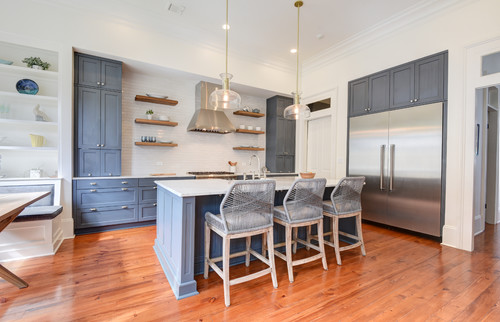
Photo by Cabinets by Design
You can’t go wrong with basic white in the kitchen. It channels a clean vibe that’s easy to live with, and makes resale a breeze when you’re ready to move.
But a little color is also lovely, especially cool blue hues and trendy pastels. A handy DIYer can fix up kitchen cabinets with a fresh color coat in a couple of days. (It’ll cost you only the paint and brushes—and your time.)
Marty Basher, a professional organizer with Modular Closets, votes for matte paint finishes over glossy, as the latter sheen can veer into garish territory.
“Choose muted colors in jewel and earth tones instead of overly bright ones for a more luxe feel,” he says.
2. Install brushed-brass accents
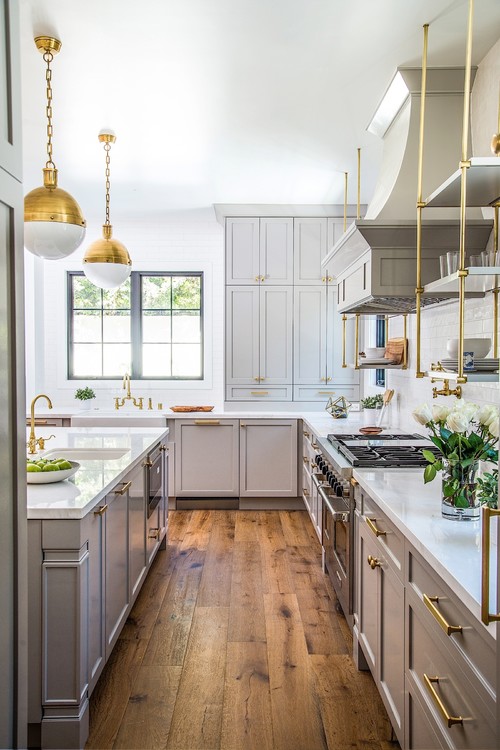
Photo by Boswell Construction
This one’s easy: Grab a screwdriver and put in new drawer pulls, says Drew Henry of Design Dudes.
“It’s supereasy to upgrade your cabinets with different hardware, and it’ll give you a lovely look,” he says.
Henry’s pick: brushed brass for a chic but quiet appeal.
“And go for elongated drawer pulls with clean angles over small knobs,” he adds.
3. Brighten cabinet backs
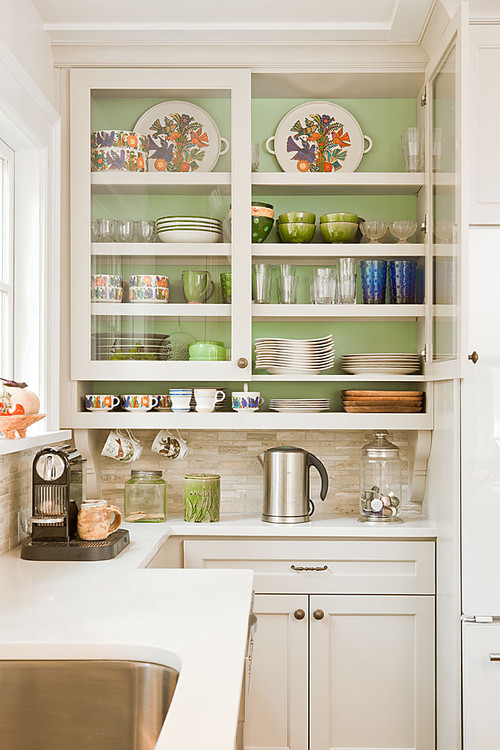
Photo by Alair Homes Decatur
Glass-front cabinets are all the rage—you might even have a set in your kitchen right now. But rather than style (and restyle) the plate stacks and glasses inside, let paint step in (again) to do the tough work of updating and beautifying your workaday cabinets.
“A fun pop of color on the backs of a few glass-front cabinets adds interest to the room and lightens up the look,” Henry says.
4. Add temporary wallpaper
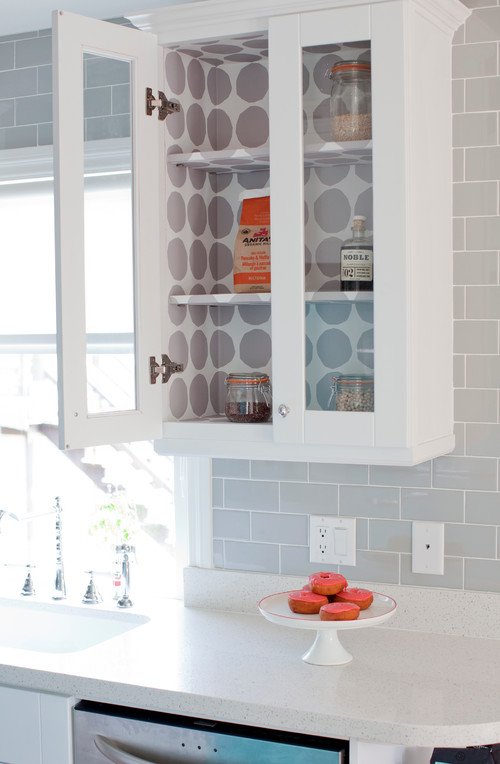
Photo by The Cross Interior Design
Just as bright paint can enliven your cereal bowl display, so too can a couple of pieces of wallpaper. Even better: Make it temporary paper, which you can remove anytime you need a change.
And don’t stop with cabinet backs—temporary wallpaper is a nifty surprise along your drawers’ outside edges. (Just pull the drawers open to reveal a pretty pattern.)
5. Put in under-cabinet lighting
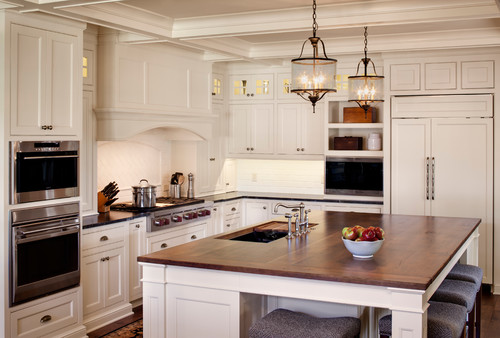
Photo by Bartelt. The Remodeling Resource
You know that gorgeous glow you spy on Instagram when you’re scrolling kitchen renovations? It comes from under-cabinet lighting. This smart upgrade brightens shadows that are invariably created by overhead pendants and can be installed by a pro for just a couple hundred bucks.
Want to go cheaper? You can get lights that plug in to existing sockets or grab some adhesive lights to press on in dark corners. Or just place a couple of small lamps you already own along counters under your cabinets.
6. Consider smart storage
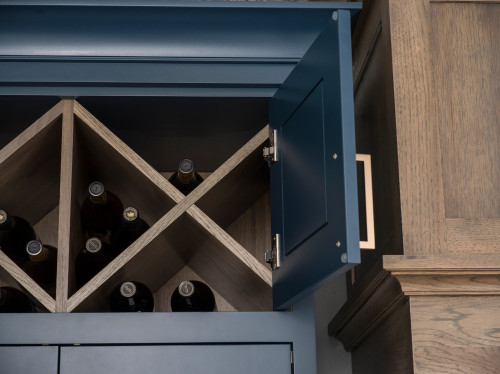
Photo by Dura Supreme Cabinetry
A simple rack or drawer rearrangement can take advantage of unused kitchen cabinet space. If you’re a wine person, you can quickly create an X design with plain wood for stacking bottles on their sides.
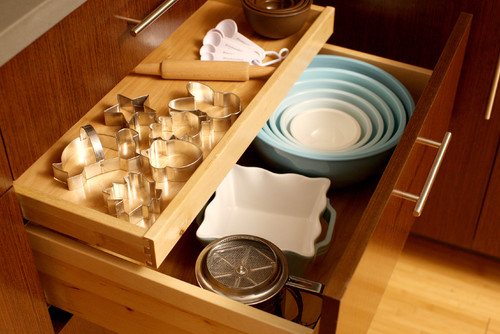
Photo by Dura Supreme Cabinetry
Or if baking’s your game, a shallow pull-out to store cookie cutters means you’ll never lose these little tin items again.
7. Decorate your cabinets with molding
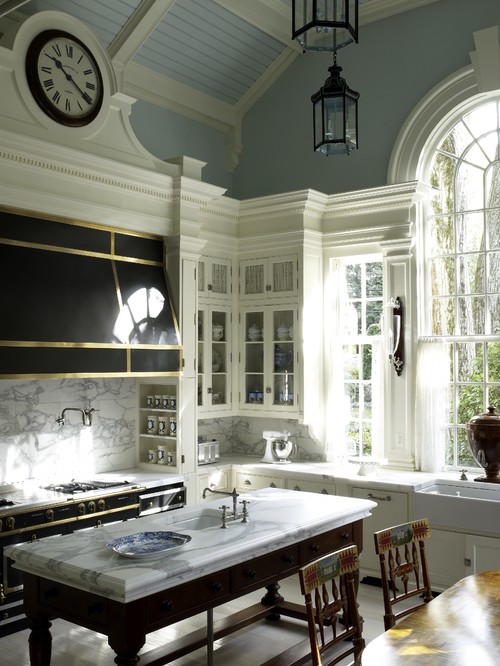
Photo by Anthony Baratta LLC
You may not notice it at first, but molding is the unsung decor hero in every room. Simple pieces of crown molding, whether stacked, stepped, or the traditional variety, can be added to the tops of your cabinets for an upgrade that looks custom and expensive.
Karen Gray-Plaisted of Design Solutions KGP approves of crown molding on top of cabinets as it extends the design right the ceiling.
“Or reconfigure just a couple of upper cabinets to reach your ceiling like the ones around the sink or refrigerator area,” she says.
You might also try bottom molding, which is just what it sounds like: decorative pieces you attach to the edges or the base of lower cabinets or the kitchen island.
Adding these “feet” transforms lowers or an island, making them look like pieces of furniture.


Annual Newport Beach Christmas Boat Parade
Newport Beach/Newport Bay
December 15 – 19, 2021
FREE to the public. The boat parade will light up the harbor for five consecutive nights. The parade starts at Collins Island at 6:30 p.m. and will last approximately three and a half hours over 250 ships participate in the parade along with hundreds of water front estates. Providing the backdrop for the parade is the Ring of Lights waterfront home and business decorating competition. FREE for spectators, entry fee for participating boats. Over million and half people view the parade each year.
For those of you that would like to be in parade both Newport Landing and Davey’s Locker will offer 3 general admission cruises nightly every night of the parade that are a part of the actual parade. Viewing the parade from a ship means that you see all of the parade and homes in full decor that line the waterfront. General admission tickets can be reserved over the phone.
LOCATIONS FOR CRUISES:
December 3, 2021 – January 2, 2022
Offered three times nightly (check websites for times)
Newport Landing
309 Palm – Suite A, Newport Beach Ca 92661
Davey’s Locker
400 Main St., Newport Beach, CA 92661
INFORMATION:
949-675-0551

Charles Dickens’ A Christmas Carol
November 27 – December 26, 2021
Orange County’s favorite yuletide tradition continues! From the first “Bah humbug” to the final “Wassail,” this timeless classic is sure to rekindle your holiday spirit. Join all your favorite Dickens characters—Tiny Tim and the Cratchit family, the Fezziwigs, the Ghosts of Christmas past, present and yet-to-come, and of course, everyone’s favorite curmudgeon, Ebenezer Scrooge, portrayed by SCR Founding Member Richard Doyle.
LOCATION:
South Coast Repertory
655 Town Center Drive
Costa Mesa, CA
INFORMATION:
(714) 708-5555

Night of Lights OC
November 26, 2021 – January 2, 2022
A spectacular drive-thru experience with over a million lights, holiday music, characters and real snow!
Guests will enjoy in the safety of their own vehicle a magical and interactive drive through a winter wonderland of lights. This one-mile drive-thru will include over one million lights. Limited tickets and time slots per day!
LOCATION:
OC Fair & Event Center
88 Fair Dr
Costa Mesa, CA 92626

Winter Fest OC – Costa Mesa
18 Days of Snow!
Featuring ice tubing down an 8 lane, 150 foot mountain, massive snow play and slide area with separate areas for toddlers and kids with fresh snow blown in daily, ice skating on SoCal’s largest outdoor ice rink under the stars in the middle of Winter Fest OC, nightly Christmas tree lighting celebration with a parade of the Winter Fest OC characters.
There’s also fireworks and snow flurries, plus a not to be missed experience with Santa and his reindeer flying over the fairgrounds through Christmas Eve, an all new Alpine Village with a new light maze and new wintery attractions, over 20 carnival rides and attractions, festive entertainment, seasonal eateries, visits with Santa and so much more.
LOCATION:
OC Fair & Event Center
88 Fair Dr
Costa Mesa, CA 92626

The Muckenthaler Cultural Center Holiday Festival
Sunday, December 19, 2021
12-4pm
The Muckenthaler’s annual Holiday Festival features various activities, including family-friendly activities, live music, free art workshops for kids, and an arts and crafts sale. Featuring Performances by Noelle Lidyoff, The Sugar Daddies, The Kamaaina Glee Club, & Momentum Dance.
LOCATION:
The Muckenthaler Cultural Center
1201 West Malvern Avenue
Fullerton, California 92833

The Nutcracker by Ballet Repertory Theatre – Huntington Beach
December 11-24, 2021
Enjoy Ballet Repertory Theatre’s cherished 45-year-old tradition of bringing beloved holiday music to life with nearly 300 performers in dazzling costumes. Travel with young Clara through a magical world of life-size dolls, toy soldiers, colossal mice, and delicate snowflakes to the fabulous Land of Sweets, home of the Sugar Plum Fairy and her Cavalier. Exuberant French, Spanish, Arabian, Russian, and Chinese dancers await you, along with twirling candy canes and waltzing flowers. Orange County’s longest-running Nutcracker is the ultimate feel-good family tradition.
LOCATION:
Golden West College Theater
15751 Gothard Street
Huntington Beach, CA 92647
INFORMATION:
714-895-8150

Christmas Countdown
December 12-23, 2021
On the first day of Christmas, my true love gave to me…holiday fun at Pretend City! Join us for our exciting 12 Days of Christmas Countdown! Each day leading up to Christmas, we will “unwrap” a new holiday activity at the museum! Get in the holiday spirit as we gear up for Christmas and countdown the days!
Cost is included with museum admission.
LOCATION:
Pretend City Children’s Museum
29 Hubble
Irvine, CA

Festival of Kwanzaa
December 26-31, 2021
Join us as we celebrate Kwanzaa at Pretend City! Each day we will light a candle on the Kinara and celebrate a new principle through a variety of activities.
Cost is included with museum admission.
LOCATION:
Pretend City Children’s Museum
29 Hubble
Irvine, CA

For Kids!
Annual Noon-Year’s Confetti Countdown
Friday, December 31, 2021
5..4..3..2..1..HAPPY NOON YEAR! Join us for our annual New Year’s Celebration in the middle of the day! We will celebrate the new year at different times throughout the day as the sun travels across the different time zones! There will be a confetti countdown at 4 different times to celebrate the new year in Bangladesh, Dubai, Athens, and London, as it turns to midnight in these different cities! We will also have New Year’s activities and art for our little ones to enjoy!
LOCATION:
Pretend City Children’s Museum
29 Hubble, Irvine, CA
INFORMATION / TICKETS:
949.428.3900
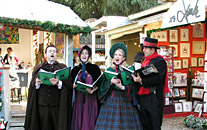
Sawdust Winter Fantasy
November 20-21 & 26-28, 2021
December 4-5, 11-12 & 18-19, 2021
Weekends – 10am to 7pm
This unique fair offers shoppers the opportunity to purchase unique artisan crafts from various local artists. Includes live entertainment, hands-on art projects and picture-perfect moments, the Sawdust Art Festival’s Winter Fantasy will become your family’s holiday tradition.
LOCATION:
Sawdust Art Festival
935 Laguna Canyon Rd
INFORMATION:
949-494-3030

Laguna Playhouse: Sister’s Christmas Catechism
December 20 & 21, 2021
It’s “CSI: Bethlehem” in this holiday mystery extravaganza from the author of Late Nite Catechism, as Sister takes on the mystery that has intrigued historians throughout the ages – whatever happened to the Magi’s gold? (“We know that Mary used the frankincense and myrrh as a sort of potpourri – they were in a barn after all.”) Retelling the story of the nativity, as only Sister can, this hilarious holiday production has been vaccinated, masked and ready to take on Christmas in a very Sister way.
LOCATION:
Laguna Playhouse
606 Laguna Canyon Road
Laguna Beach, CA 92652
INFORMATION:
Box Office (949) 497-ARTS (2787)

Casa Lumina: Holiday Garden Walk – San Clemente
December 1-22, 2021
Experience the wonder of the holiday season during “Casa Lumina Holiday Walk” on select evenings from December 5 to 23 at Casa Romantica. Over 1,000 twinkling lights illuminate Casa Romantica’s exquisitely-decorated home and gardens with holiday themes.
$8-$12
LOCATION:
Casa Romantica Cultural Center and Gardens
415 Avenida Granada
San Clemente, CA 92672
INFORMATION:
(949) 498-2139

Camino Real Playhouse presents: A Christmas Story
November 26th – December 19th, 2021
Christmas is approaching and 9 year-old Ralphie wants only one thing: a Red Ryder Range 200 Shot BB gun. When he mentions it at the dinner table, his mother’s immediate reaction is that he’ll shoot his eye out. He then decides on a perfect theme for his teacher but her reaction is like his mother’s. He fantasizes about what it would be like to be Red Ryder and catch the bad guys. When the big day arrives, he gets lots of presents under the tree including a lovely gift from his aunt that his mother just adores. But what about the BB gun?
LOCATION:
Camino Real Playhouse
31776 El Camino Real
San Juan Capistrano, CA 92675 675
INFORMATION:
(949) 489-8082

Snow Day with the Critters
December
All Zoo celebration featuring stations focusing on winter and snow. Watch animals receive icy treats, listen to festive music, enjoy the winter decorations, play educational games, create cool crafts and listen to delightful winter stories.
General Public – free with price of admission; FOSAZ Members are FREE and Santa Ana Residents are FREE on December 15.
LOCATION:
Santa Ana Zoo
1801 E Chestnut Ave
Santa Ana, CA

Kidseum New Years Eve Bash
December
New Year’s Eve isn’t just for adults- head to Kidseum for a kid-friendly countdown! Families will enjoy complimentary face painting and craft stations where they can make their own disco balls, confetti poppers, and even noise makers during this kid-centric celebration.
Ticketed Event: Member or with paid Bowers Museum admission $15 | General $20
LOCATION:
Bowers Museum
2002 North Main Street
Santa Ana
INFORMATION:
(714) 567-3679

The Nixon Library presents “A Holiday of Hope” – Yorba Linda
November 18 through December 28, 2021
All Aboard! Trains are Back!
Every week, Nixon Library visitors will enjoy rotating sets of model trains chugging up mountains and rolling across the American plains. Visit the Nixon Library throughout the Holiday season to keep up with the latest rotating model! New trains every week!
LOCATION:
Richard Nixon Presidential Library and Museum
18001 Yorba Linda Blvd.
Yorba Linda, CA 92886
INFORMATION:
714-993-5075
In today’s housing market, the number of homes for sale is
much lower than the strong buyer demand. As a result, homeowners ready to sell have a significant
advantage. Here are three ways today’s
low inventory will set you up for a win when you sell this season.
1. Higher Prices
With so many more buyers in the market than homes available for sale, homebuyers are frequently getting into bidding wars for the houses they want to purchase. According to the latest data from the National Association of Realtors (NAR), homes are receiving an average of 3.7 offers in today’s market. This buyer competition drives home prices up. As a seller, this certainly works to your advantage, potentially netting you more for your house when you close the deal.
2. Greater Return on Your Investment
Rising prices mean homes are also gaining value, which increases the equity you have in your home. In the latest Homeowner Equity Insights Report, CoreLogic explains:
“In the second quarter of 2021, the average homeowner gained approximately $51,500 in equity during the past year.”
This year-over-year growth in equity gives you the ability to sell your house and then put that money toward a down payment on your next home, or to keep it as extra savings.
3. Better Terms
In a sellers’ market like we have today, you’re in the driver’s seat if you make a move. You have the power to sell on your terms, and buyers are more likely to work with you if it means they can finally land their dream home.
So, is low housing inventory a big deal?
Yes, especially if you want to sell on your terms. Moving now while inventory is so low is key to maximizing your opportunities.
Bottom Line
If you’re interested in taking advantage of the current sellers’ market, let’s connect today to determine your best move.
? Contact us today!
? Christine Almarines @carealestategroup
Realtor DRE # 01412944
714-476-4637 | christine@carealestategroup.com
? Michelle Kim @michellejeankim_homes
Realtor DRE # 01885912
714-253-7531 | michelle@carealestategroup.com
CA REAL ESTATE GROUP powered by Keller Williams Realty
linktr.ee/carealestategroup
By Sally Jones | Realtor.com | Dec 13, 2021
Freshly brewed java doesn’t have a season, as any coffee aficionado knows. But with holiday decorating upon us, caffeine lovers of Instagram are showing off their seasonal coffee stations and hot cocoa bars.
Why have these hot-beverage stations become a holiday trend? Because a cozy drink is like (getting or giving) a hug in a mug.
“Warm beverages not only warm the body, but they also warm the soul,” says Annemarie Schumacher, event planner and founder of Make Every Day an Event at Schumacher Creative. “People crave nostalgia during the holiday season, and things like hot cocoa bring us back to our childhood.”
Whether you confine your coffee station to a corner of your kitchen or go all out with a sideboard takeover, there are many ways to put your decor-style stamp on a beverage bar.
Ready to give the whole house a spike of holiday cheer? Here are Instagram’s best holiday drink stations to inspire you as well as tips on how to shop the look.
1. Ribbons and trim

Setting up a coffee station doesn’t mean you have to become a barista. Instead, let folks serve themselves.
“These days, there are a variety of warm beverage makers that make the logistics of a beverage bar super easy,” says Schumacher.
And to dress things up for the season, you can add some homespun charm to a white kitchen backdrop. Just tie some colorful ribbons and bows along a length of string to make a fun and easy garland. Red is the right pop of color for a holiday coffee bar.
Get the look: Glad tidings are here in this striped red and white ribbon ($3.99).
2. Wall art
A cocoa bar doesn’t have to be elaborate.
“Holiday-themed signs are a great way to add a festive look and feel to a beverage bar,” says Cate Griffing, who runs the painting-based website West Magnolia Charm, which also includes topics regarding decor and home improvement. “It’s a simple piece of decor that doesn’t take up a ton of space but can pack a lot of punch.”
Get the look: Look for your expressive wall art to find your perfect holiday message and build your tableau around it.
3. Santa mugs
Bring on the mugs!
“You can’t have a hot cocoa station for the holidays without some darling Christmas mugs,” says Schumacher. “Perhaps you have some coffee cups or mugs that have been passed down from generation to generation. I personally love the sentiment.”
You’ll find an assortment of Christmas ceramics at your favorite kitchen and home goods stores. And have some fun by mixing and matching styles.
Get the look: Sip from your very own Santa mug like this one from Sur La Table ($10).
4. Holiday bunting
Holiday bunting adds a festive touch to this coffee, tea, and cocoa station. Don’t be afraid to layer on several different strands—the more, the merrier. This bar features three: white “snow” balls, glittering confetti, and red felt.
“And trays are a useful tool in creating a coffee bar,” says Griffing. “If you aren’t lucky enough to have a separate coffee station in your home, a tray allows you to designate one by organizing all the coffee supplies in one place.”
Get the look: Nab your very own cheerful holiday bunting ($23), and check out which tiered tray suits your holiday style ($37).
5. Vintage thermos
This display of retro thermos bottles in red plaid brings to mind scenes of snowy days spent sledding and ice skating. It’s a unique way to summon both the spirit and nostalgia of the season to your beverage bar. And the idea is a practical one, too: Thermoses come in handy on days when you need to take your coffee on the go.
Get the look: Check out Etsy for a wide variety of vintage thermoses ($25 to $35).
6. Bar cart
If you can imagine your coffee station becoming a tradition, you may want to invest in a bar cart. With a cart, you not only get your hot-drinks station off the kitchen counter, you can also wheel it into the living room when you’re entertaining.
“Who can resist the coziness of sipping a delightful mug of hot chocolate in a darling mug while surrounded by the twinkling lights of your Christmas tree,” says Schumacher. Bonus: You can turn it back into a bar cart when the season ends.
Get the look: Check out this Falon modern glam bar cart to get rolling.
7. Upcycled sideboard
Another idea for a permanent coffee station is to upcycle a vintage sideboard.
“I encourage people to find a sideboard, console table, or bar cart to curate their station,” says Schumacher.
To get a similar “white Christmas” theme going at your house, try painting your upcycled furniture with milk paint, which needs very little prep work and has a matte finish that lets a bit of the natural wood show through.
Get the look: Once you find the perfect sideboard, grab a gallon or two of milk paint ($23).
By Margaret Heidenry | Realtor.com | Sep 26, 2021
How much does it cost to build a house? Is it cheaper to build or buy a house? The median price of constructing a single-family home is $296,652. That’s for an average-sized house of 2,594 square feet, which boils down to $115 per square foot.
Because of COVID-19, however, Americans keen to purchase new construction will need to tack on a pandemic premium of an extra $35,872, cranking up today’s total cost of building a house to $332,524.
Is it more expensive to build a house? The coronavirus pandemic’s impact on new construction
Why does it cost so much to build a house today? According to the National Association of Home Builders, the pandemic’s disruption of supply chains has caused lumber costs to triple over the past year. Framing lumber that once set builders back about $350 per 1,000 board feet is now running $1,200—a 250% jump in price.
“The pandemic has been a big source of unexpected shifts in supply and demand for all kinds of goods,” says Danielle Hale, chief economist of Realtor.com®. “As a consumer, you’ve likely experienced this in the form of empty shelves that didn’t have toilet paper or yeast or chicken.”
Given that a house is much bigger (and more expensive) than rolls of toilet paper, it’s understandable that new-construction homes, and the materials to make them, are suffering from an unprecedented price increase that has many homebuyers and builders reeling from sticker shock.
“This unprecedented price surge is hurting American homebuyers and home builders, and impeding housing and economic growth,” said NAHB Chairman Chuck Fowke. “These lumber price hikes are clearly unsustainable. Policymakers need to examine the lumber supply chain, identify the causes for high prices and supply constraints, and seek immediate remedies that will increase production.”
Still, the pandemic alone isn’t to blame for the high cost of building a house. Here’s more on why new construction costs so much, and how it compares with buying a preexisting home.
The main costs to build a house
Wondering if it’s cheaper to build a house? First, it’s important to understand that there are a few main costs involved in the construction of a home, says Andy Stauffer, owner and president of Stauffer and Sons Construction. Sure, each time you build a home, costs are a little different, but here are the biggies:
- The shell of the house, which includes walls, windows, doors, and roofing, can account for a third of the home’s total cost, or $93,279.
- Interior finishes such as cabinets, flooring, and countertops can eat up another third of the budget, averaging $75,259.
- Within the interior, kitchens and bathrooms are the most expensive rooms to build, with the average cost for cabinets and countertops alone is $13,540.
- Mechanical—think plumbing and heating—runs around 14.7%, or $43,668.
- Architect and engineer drawings will run about $4,335.
Also keep in mind that the cost to build a home can vary widely based on where you live.
___
Watch: Here’s Why You Might Want to Buy an Older Home Instead of a New One
Additional costs to build a house
Now you know the basic cost to build a home, but the expenses don’t end there. Here are a few extra costs you’ll need to be aware of that aren’t factored into the above price:
- The cost of a plot of land to build on averages $3,160 per acre. That said, the average home is built on only 0.5 acre, so unless you want a lot of space in a highly desired neighborhood, that alone won’t break the bank.
- Excavation and foundation work can be the most variable cost when building a home. In other words, you never know what you’re going to find until you start digging—be it bad soil or massive boulders. If excavation and foundation work go relatively smoothly, the average cost for both is $33,511.
- You’ll need a building permit, of course—it averages $5,086 nationally.
- Other costs you’ll incur before you hammer even one nail include inspections ($4,319) and an impact fee, levied by the government to cover the costs a new home will incur on public services like electricity and waste removal ($3,865).
The current state of the new-construction industry
“When the pandemic began to unfold, builders faced the prospect of buyers disappearing,” says Hale. “And while buyers did pull back early on, the housing market quickly did a 180 with buyers coming out en masse to find a better fit at home.”
Now, as the economy has begun opening back up, builders are struggling to balance strong demand with supply chain crunches beyond lumber that are leading to higher prices, causing some homebuyers to hold off on moving forward with new construction. But it’s not all doom and gloom.
“I expect that we’ll see new home sales eventually pick up in a more gradual manner as builders work through supply chain challenges and the development pipeline normalizes,” Hale adds.
Is it cheaper to build or buy a house?
Currently, you can buy an existing single-family house for a median price of $380,000.
In short, it’ll cost you a little bit more today to buy an old house than building a new one. Still, you save yourself the headaches that inevitably come with construction, along with the long wait before you move in. On average, the time it takes to build a house is about three to six months, but the pandemic could cause this process to drag even longer.
Still, building a house does have its advantages. Everything from pipes to the heating and cooling systems will be new. That means no costly repairs in the near future—and so a newly built home could end up costing less in the long run.
Should you buy or build a house?
All in all, it’s smart to weigh the pros and cons of new versus old construction—and the price you pay for construction costs versus an existing home is only the beginning. Here we lay out everything a homebuyer needs to know about buying an existing home compared with building one from scratch or having it built by a general contractor.
There are actually two things to consider: the upfront costs of buying versus building, and the ongoing maintenance costs.
The upfront costs
If you buy an existing home: According to the latest figures, the median cost of buying an existing single-family house is $334,500. For the average 1,500-square-foot home built before the 1960s, that comes to about $223 per square foot. That said, the exact price can vary widely based on where you live. (Go to realtor.com/local to see the price per square foot in your area.)
If you build a new home: Building a house will set you back an average of $296,652, plus about $35,872 due to the pandemic-related uptick in material costs.
But you may get a lot more for your money. For one, new construction is usually more spacious, with a median size of 2,594 square feet—so the cost to build per square foot is actually lower than the cost per square foot of existing homes.
Another advantage of having a builder construct a custom home is you pay for only what you want, whereas an existing home may have interior and exterior features (e.g., a finished basement or a basketball court) you’ll pay a premium for, even if you don’t want them. But if an older house happens to be your dream home the way it is, that may be the more bargain-friendly route.
Last but not least, by building your own house, you get to design it to your exact specifications. If you have very clear ideas about how you want your home to look, this blank slate could be worth every penny.
Maintenance
If you buy an existing home: Older homes have more wear and tear, which means certain things may need more maintenance—or, if they’re on their last legs, replacement, points out Michael Schaffer, a broker associate at Keller Williams Integrity Real Estate LLC.
Naturally, the cost of this upkeep isn’t cheap, so make sure you know the age of the main items. For example, the average furnace is expected to last 20 years and will cost $4,551 to replace. The typical HVAC system lasts 15 years and costs $7,000 and more to replace.
Another biggie is the roof: The average shingled roof holds up for about 25 years. If you need to replace roofing, you’re looking at a bill starting at $8,379. Plumbing and septic systems can go for some time without a problem, but when something goes wrong, it’s an emergency.
With an existing home, unless you step into a high-end home with everything you want, you may want to start changing things, even if they are still functional. Home improvement shows make it seem simple to change countertops and flooring, or even overhaul floor plans. When you’re paying for material that’s shot up in price recently and labor costs for plumbing and drywall work, you may start to think your total cost might have been less paying a builder for a custom home in the first place.
If you build a new home: Considerably less upkeep is one of the primary reasons to build your own single-family home, because everything from major appliances to the HVAC system is new and under warranty. In fact, sometimes the entire home is protected for up to 10 years because a builder generally offers a construction warranty “for any problems that arise,” says Schaffer. Your interior and exterior maintenance outlay for a decade is potentially zero dollars. That can make up for some home construction costs per square foot that you paid by opting for a custom home.
Landscaping
If you buy an existing home: A major perk of older homes is mature landscaping with large trees and established plantings. That may not seem like a big deal until you consider that the U.S. Forest Service estimates that strategically placed mature trees can add tens of thousands of dollars to a property’s value and save up to 56% on annual air-conditioning costs.
If you build a new home: Builders often do little or no landscaping to new construction. It may take thousands of dollars—and many years—to get the yard you want. For instance, one 6- to 7-foot-tall red maple will cost about $99.95 (if you plant it yourself), which will then grow 2 to 3 feet a year. According to HomeAdvisor, the cost of adding completely new landscaping ranges from $1,400 to $5,700-plus.
Energy efficiency
If you buy an existing home: The latest U.S. Census found the median age of American houses to be 46 years old as of 2020. Older construction means dated windows and appliances—dollars flying out the window on wasted energy expense.
If you build your own home: Recent construction almost always beats older homes in energy efficiency, says Kyle Alfriend of the Alfriend Real Estate Group Re/Max in Ohio. Homes built after 2000 consume on average 21% less energy for heating than older homes, mainly because of their increased efficiency of heating equipment and building materials. This translates into reduced energy expense every month, even with the higher square footage in many newer homes.
“However, often the regulatory requirements on new construction are stricter than existing buildings,” says Hale. “This can mean you enjoy better energy efficiency, but these requirements can also drive up the price of new homes and mean that they take longer to build.”
Appreciation
If you buy an existing home: The nice thing about old homes is that there’s context to your purchase: You can research the home’s previous sale prices, as well as prices of similar homes in the area (known as comparables, or comps) to get a feel for whether prices are rising or falling in your area. If the prices for your home and others in the area have been steadily rising, odds are decent that the trend will continue, which bodes well for you if you decide to sell later on.
If you build a new home: New house construction, particularly in up-and-coming neighborhoods, can be more of a gamble. Without a proven track record of lots of comps, there just aren’t enough data points to really know what could happen down the line. However, some buyers in hot markets are seeing incredibly quick jumps in their new-construction property value.













 Christine Almarines
Christine Almarines 


 Ingredients
Ingredients
































